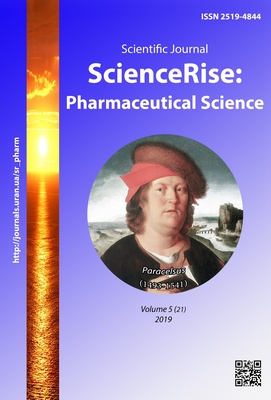Studies of physico-chemical and pharmaco-technological parameters of bioflavonoids diosmin and hesperidin
DOI:
https://doi.org/10.15587/2519-4852.2019.182412Keywords:
diosmin, hesperidin, pharmaco-technological study, microscopically researches, moisture absorption, solubility, derivatographic characteristicsAbstract
The use of medicinal substances of herbal origin are perspective direction for the development sector of the pharmaceutical industry of healthcare in Ukraine, even though increased demand for synthetic medicines. The natural substances that have a wide range of therapeutic effects, low toxicity and can be used in therapy of anorectal diseases is diosmin and hesperidin. In the pharmaceutical market of Ukraine the substances of diosmin and hesperidin are presented as solid dosage forms, which can be used for treatment of chronic venous insufficiency. It is appropriate to development composition and technology of new combination dosage form, which can purposefully release active substances in the places of progressing pathological process. The definition of substance properties is based on a comprehensive research, which results will have a significant impact on the technology of obtaining a new drug.
The aim of the work was physic-chemical and pharmaco-technological researches of substances diosmin and hesperidin.
Results. The result of our work were carrying out a microscopic research, which is confirming results a differential curve of particle distribution, studied derivatographic characteristics of the substances, moisture absorption and solubility. Based on the research it can be concluded about insufficient solubility of diosmin and hesperidin, their high hygroscopicity and high critical degradation of substances. According to the results of microscopic analysis, diosmin has a few fractions with different distributions of particles and hesperidin has capable of agglomeration.
Conclusions. On the basis of research it can be concluded for the feasibility of further research, which can improve properties of the substances diosmin and hesperidin. The results of research can be concluded, that conducted results will have impact on development of the composition and technology of the new dosage form with diosmin and hesperidin
References
- Yang, B., Liu, H., Yang, J., Gupta, V. K., Jiang, Y. (2018). New insights on bioactivities and biosynthesis of flavonoid glycosides. Trends in Food Science & Technology, 79, 116–124. doi: http://doi.org/10.1016/j.tifs.2018.07.006
- Borko, Ye. A., Kovalevskaya, I. V. (2018). The urgency of creating a new drug for the treatment of diseases of the anorectal zone with bioflavonoids. Scientific and technological progress and optimization of technological processes for the creation of drugs. Ternopil: TDMU "Ukrmedkniga", 93–94.
- Palienko, R. K., Yosipenko, M. K. (2005). Comparative analysis of the clinical efficacy of semi-synthetic diosmin in the treatment of acute hemorrhoids. Surgery, 1 (13), 13–20.
- Li, C., Schluesener, H. (2015). Health-promoting effects of the citrus flavanone hesperidin. Critical Reviews in Food Science and Nutrition, 57 (3), 613–631. doi: http://doi.org/10.1080/10408398.2014.906382
- Silambarasan, T., Raja, B. (2012). Diosmin, a bioflavonoid reverses alterations in blood pressure, nitric oxide, lipid peroxides and antioxidant status in DOCA-salt induced hypertensive rats. European Journal of Pharmacology, 679 (1-3), 81–89. doi: http://doi.org/10.1016/j.ejphar.2011.12.040
- Chen, J., Wang, Z.-Z., Kong, L.-L., Chen, N.-H. (2018). Hesperidin. Natural Small Molecule Drugs from Plants. Singapore: Springer, 81–86. doi: http://doi.org/10.1007/978-981-10-8022-7_13
- Freag, M. S., Elnaggar, Y. S. R., Abdallah, O. Y. (2013). Development of novel polymer-stabilized diosmin nanosuspensions: In vitro appraisal and ex vivo permeation. International Journal of Pharmaceutics, 454 (1), 462–471. doi: http://doi.org/10.1016/j.ijpharm.2013.06.039
- Panakanti, R., Narang, A. S. (2015). Impact of Excipient Interactions on Drug Bioavailability from Solid Dosage Forms. Excipient Applications in Formulation Design and Drug Delivery. Cham: Springer, 273–310. doi: http://doi.org/10.1007/978-3-319-20206-8_10
- Kononenko, N. M., Renyova, I. M., Borko, E. A. (2019). Prospects for the creation of suppositories based on diosmin for the treatment of hemorrhoids, proctitis and other proctological diseases. Medicines – human. Current Problems of Pharmacotherapy and Prescription of Medicines. Kharkiv: NFaU, 2, 149–150.
- Shalaby, K., M. Samy, A., Kassem, A., F. Ibrahim, M., K. Alruwaili, N., M. Ali, H., Elmowafy, M. (2019). Formulation, in vitro and Bioavailability Assessments of Ranitidine Rectal Suppositories. Journal of Pharmaceutical Research International, 1–10. doi: http://doi.org/10.9734/jpri/2019/v30i130262
- Hua, S. (2019). Physiological and Pharmaceutical Considerations for Rectal Drug Formulations. Frontiers in Pharmacology, 10. doi: http://doi.org/10.3389/fphar.2019.01196
- Kovalevska, I. V., Borko, Ye. A., Poluian, S. M. (2019). A study of the influence of solvents on crystallographic characteristics of local anesthetics. Annals of Mechnikov Institute, 1, 17–22.
- Korolev, D. V., Naumov, V. N., Suvorov, K. A. (2005). Determination of the dispersed composition of powders by microscopic method. Saint Petersburg: GOU VPO SPbGTI (TU), 41.
- Pabst, W., Gregorova, E. (2007). Characterization of particles and particle systems. ICT Prague, 122, 122.
- State Pharmacopoeia of Ukraine (2001). Kharkiv: RIREG, State Enterprise "Scientific Expert Pharmacopoeial Center", 556.
- Snezhkin, Y., Petrova, J. (2017). Derivatographic study of dehydration of betanine-containing plant materials and their thermal stability. Scientific Works, 80, 80–89.
- Kohli, K., Chopra, S., Dhar, D., Arora, S., Khar, R. K. (2010). Self-emulsifying drug delivery systems: an approach to enhance oral bioavailability. Drug Discovery Today, 15 (21-22), 958–965. doi: http://doi.org/10.1016/j.drudis.2010.08.007
Downloads
Published
How to Cite
Issue
Section
License
Copyright (c) 2019 Yelyzaveta Borko, Inna Kovalevska

This work is licensed under a Creative Commons Attribution 4.0 International License.
Our journal abides by the Creative Commons CC BY copyright rights and permissions for open access journals.








